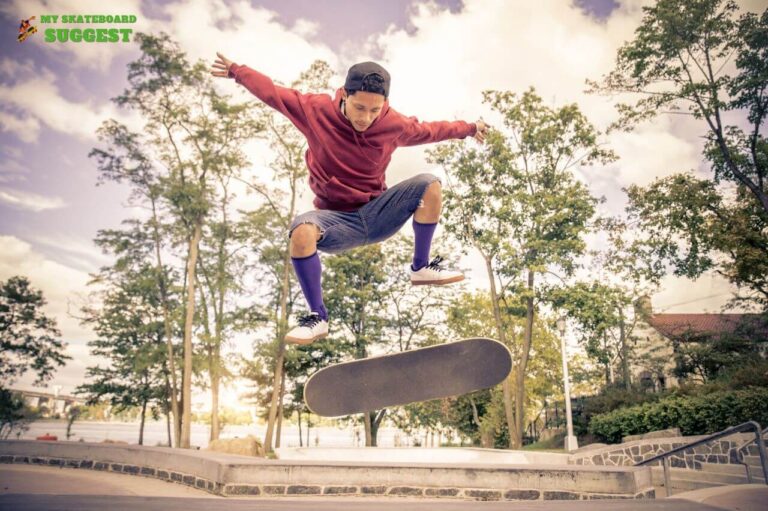Greetings, fellow skaters! Whether you’re a pavement-pounding pro or just stepping onto the scene, there’s a fundamental aspect of skateboarding that even the most seasoned riders occasionally ponder—the age-old question of “How do you tell the tail from the nose of a skateboard?”
Fear not, for I’m Matt, your skateboarding confidant, and I’m here to unravel the mysteries hidden beneath our trusty decks.
In the dynamic world of skateboarding, knowing your tail from your nose is more than just preventing an embarrassing mix-up—it’s the key to unlocking a whole realm of tricks, flips, and maneuvers.
Join me on this gripping ride as we explore the tactile sensations, graphic clues, and practical applications that will forever change the way you view the front and back of your skateboard.
So, strap on your helmet, tighten those trucks, and dive into the intriguing universe of skateboard anatomy.
It’s time to master telling the tail and nose apart!

The Anatomy 101: Tail vs. Nose
Before we jump into the practical side, let’s get acquainted with the anatomy of a skateboard.
Every deck has two distinct ends—the tail and the nose.
The tail is the back of the board, usually slightly broader and steeper than the nose.
Conversely, the nose is the front, often featuring a more rounded and less steep design, and knowing which end is which is the first step in unlocking your skateboard’s potential.
Understanding the differences in shape, size, and concave between the tail and nose is crucial.
The tail’s steeper incline gives it an edge in executing pop-heavy tricks, while the rounded nose aids in smooth landings and stability during certain maneuvers.
Feeling the Concave: A Tactile Guide
One foolproof way to distinguish the tail from the nose is by feeling the concave.
The concave refers to the curvature along the width of the deck.
Typically, the concave is more pronounced on the tail, providing extra leverage for ollies and flips.
Run your fingers along the edges, and you’ll notice the subtle but significant differences.
The concave on the tail is your secret weapon for locking in those flicks and pops.
It offers a tactile advantage, allowing your foot to nestle securely for maximum control.
Experiment with your board on flat ground, feeling how your feet interact with the concave on both ends.
This hands-on approach will make you intimately familiar with the nuances of your skateboard.
Graphic Tells: Unveiling Design Clues
Skateboard graphics aren’t just there to make your deck look rad—they often carry subtle hints about the tail and nose.
Many manufacturers strategically place logos or designs closer to the nose, providing a visual cue for quick identification.
Keep an eye out for these graphic tells, and you’ll never mix up the ends of your board again.
Graphics are not just about aesthetics; they serve a functional purpose, too.
Take a closer look at the artwork on your deck, and you might find an arrow pointing toward the nose or tail.
It’s a designer saying, “This is the front!” Let your board’s art be your guide in navigating the correct orientation.
Kick it Up: Recognizing the Kicktail.
The kicktail is a dead giveaway for distinguishing the tail from the nose.
The kicktail is a raised, upturned section at the back of the board that aids in executing tricks like ollies and kickflips.
Simply put, the tail is where the kicktail resides.
Practice some manual turns, pivots, or pop an ollie.
The kicktail is your pivot point, and getting comfortable with its location will make your board an extension of your feet.
Soon, you’ll instinctively know where the tail is just by sensing the kicktail beneath your heel.
Nose Manuals and Tail Slides: Practical Applications
Knowing the front from the back isn’t just about avoiding embarrassing mishaps—it’s about unlocking the full potential of your skateboarding experience.
Each end serves a unique purpose, and understanding how to leverage the tail and nose can elevate your trick game.
When attempting nose manuals, having the correct orientation is paramount.
The rounded nose provides a stable platform for balancing, making those long-nose manuals a breeze.
On the flip side, tail slides and flip tricks heavily rely on the pop generated from the tail.
Mastering these maneuvers requires an acute awareness of your board’s anatomy.
Tail and Nose Preferences: Personalizing Your Ride
Skateboarding is not a one-size-fits-all venture.
You might gravitate towards a particular end of the board as you progress.
Some skaters prefer the snappy pop of a steep tail, while others enjoy the stability of a rounded nose.
Your skate style and trick preferences will inevitably influence your choice of tail or nose dominance.
Experiment with different setups, and pay attention to how your board responds to your riding style.
Do you find yourself executing better kickflips off the tail, or do you appreciate the control of a rounded nose during manuals?
Your skateboard is a canvas for personal expression, so make it your own.
| Aspect | Tail | Nose |
|---|---|---|
| Concave | More pronounced for leverage in tricks | Subtle, aids in stability |
| Graphic Tells | Often features logos or designs | May have arrows pointing towards it |
| Kicktail | Located at the back | Not present |
| Practical Applications | Tail slides, flip tricks | Nose manuals, stability |
| Preferences | Snappy pop, maneuverability | Stability, rounded platform |
In Conclusion
In the grand symphony of skateboarding, understanding the nuances between the tail and nose is akin to knowing your instrument inside out.
Each element plays a crucial role in the harmony of tricks and maneuvers from the concave to the kicktail.
So, the next time you step on your board, take a moment to appreciate the symmetrical poetry beneath your feet.
Skating is not just about conquering gravity; it’s about mastering the language of your deck.
The tail and nose are the verbs and nouns of this language, allowing you to express yourself on the concrete canvas.
Embrace the tactile sensations, decode the graphic clues, and let the kicktail be your compass in the urban jungle.
Now, go out there, fellow skater, and let the tail and nose guide you to new heights, flips, and grinds.
Happy shredding!


